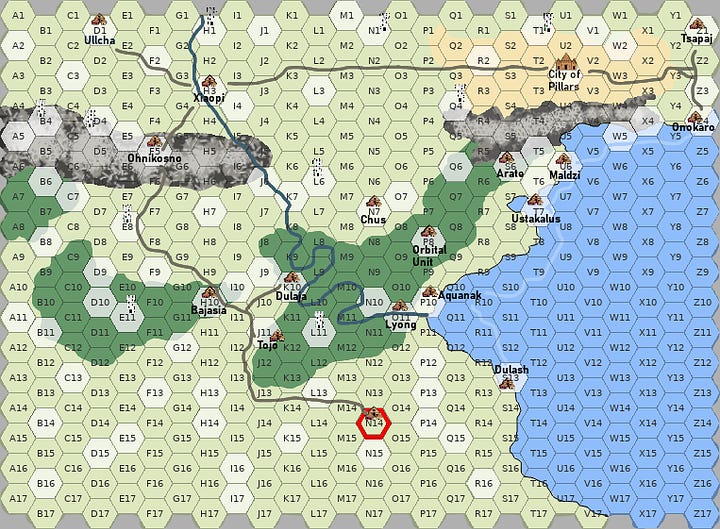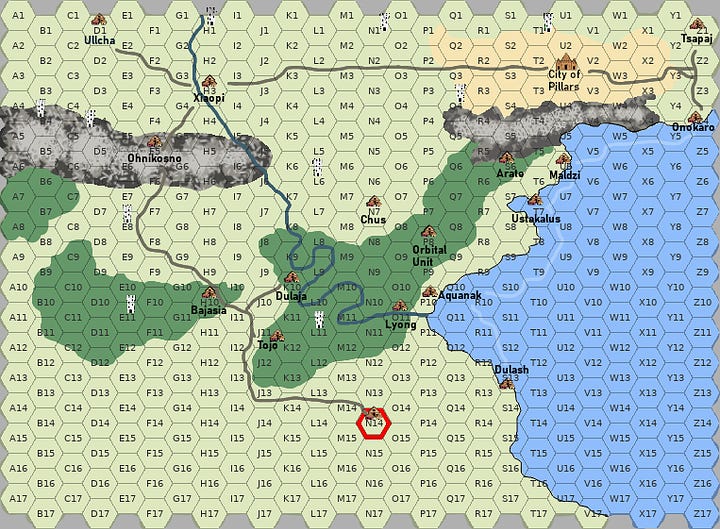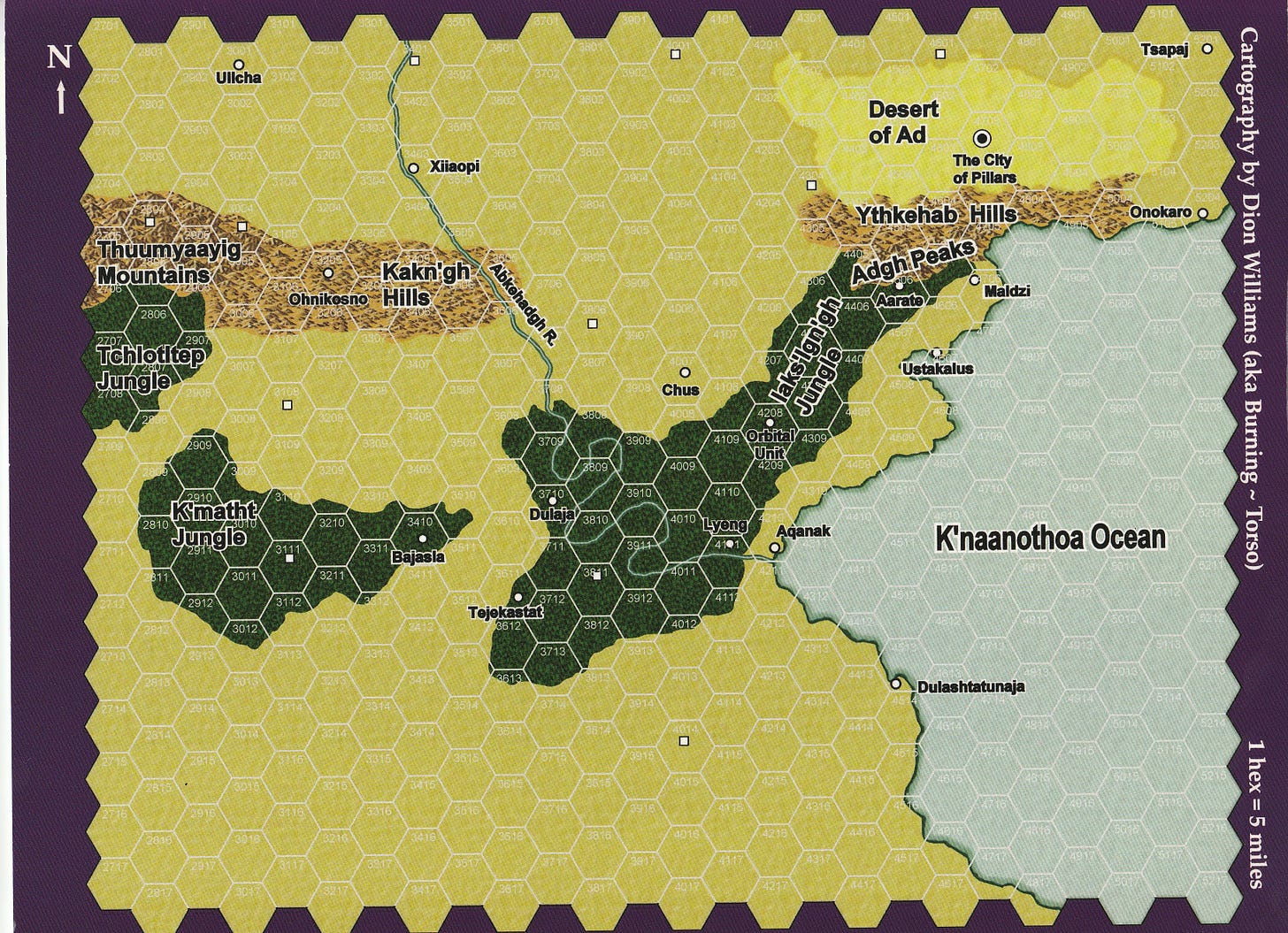This post originally appeared on my substack. You can view it and subscribe here:
https://twilightdreams.substack.com/p/masters-of-carcosa-part-2
-------------------------------
Where I last left off, I had a general pitch for my Masters of Carcosa campaign as well as a pieced together setting and hexcrawl using Geoffrey McKinney’s Carcosa hardcover book and module.
However, I also had one issue. I found the original hex map in the module not really to my liking:
It had that classic hexcrawl look and feel but I had a number of issues with it:
I found the colours to be too high contrast.
I found the white hexes and numbers hard to read.
I found it lacked info that I wanted to include. I needed two versions of the map. One which would be GM facing and include an overlay that would show all the hexes that had an encounter in them (not all hexes had an encounter) and another map which would be player facing and not have this information. I also wanted to include some things like roads and water trade routes as villages would be more important in my version of Carcosa. They’d kind of be the basic building block of civilized interaction and each one would have it’s own weird style of government and theme.
It used the traditional hex numbering of one axis being one pair of numbers and the other axis being another pair. So like 38XX in a column and XX11 being the row so you get 3811, 3812, etc. While this may be sacrosanct to some, I find such methods of labeling axis make it very hard to read what hex follows what hex and whether to flip forward or back when looking them up in text.
I wanted to add a number of my own hexes and things to the hexcrawl. To put my own twist on the setting.
So all together I came up with the following. I don’t claim to be an artist but I think my lessons learned may help others:


Carcosa Maps
The colours have less contrast and I find overall more pleasing and easier to read.
The hexcrawl uses letters along one axis and numbers along the other. I find this is much easier to parse and much easier to immediately know at a glance that column H is after column G and row 3 after row 2. Additionally, the label for each hex is in the middle of it.
The GM map has the hexes with fixed encounters labelled with a white overlay. Overall I don’t think you need a fixed encounter in every hex. I find you need to give players room to breathe, to feel like they’re traveling across a landscape where there may be just random road encounters or wandering encounters or nothing at all, rather than another fixed location.
If you look on my maps you’ll see villages (with names) and white column things that are supposed to be towers. The villages are villages and the white towers fortresses. I decided to do things this way because I found a number of the hexcrawl entries featured fortress like locations, basically lairs or bases of operations by factions with a single leader who could project force out from his base.
The players starting village, Refuge, is the village with the red outline around it’s hex.
Overall I was fairly proud of the results and it worked pretty well in play. Still, after playing for several months if I were to juice up another hexmap or create one of my own I’d do the following:
Center the Hexmap: if you’re going to start the players off in one location, and that location is probably, or supposed to be, a base of operations. Then center the hexmap on that hex. I made the mistake of putting Refuge, the players starting village they were responsible for, in the south. It took several days of travel to get to the northern city. The further the players travel from a place the less likely they are to return to it as exploring new hexes is more fun. If you put their base of operations in the center where all the ‘new’ hexes are equidistant, they’re more likely to venture out then venture back in loops. This has them interacting with the NPCs in the their base of operations more regularly.
Common map Symbols: as explained above I had a symbol on my map for villages and a symbol for fortresses. If I were to create another hexmap I’d go even further and create symbols for like 5-6 common adventuring sites, things like lairs, ruined buildings, magical standing stones, inns, etc. I would do this because while, as the GM, you’ve read the text of the hexmap and know what kind of things are to be found and roughly where they are, the players haven’t. The entire point of a hexcrawl is it’s supposed to be self-directed by the players. But if the players don’t know what kind of things lie out there in the hexworld, they’ll have a hard time setting their own goals. You can do this by dropping a lot of adventure hooks but you can also do it by simply making that information discernable on the map. In my opinion the hexmap should be something the players want to study. Not just a empty chessboard they move their pawn around. Additionally, if they do learn things in a hook, like the knights you met come from the Fortress of the North Wind to the North, they can look on the map and be able to figure out and see which Fortress is the actual fortress.
Common Resources: while the hexmap should contain a good number of truly unique and strange locations. I do think there should be 5-6 common adventuring sites. While this may make it seem like a bunch of hexes are kind of copy-pasted, I also think these adventuring sites should be thought of as resources. They aren’t just weird locations the players poke around in and leave. They are things which the players, or other factions can control and fully exploring and controlling them gives them increased power in the setting. Like a fortress can house troops and project physical force into the surrounding land. A ruined building hosts lost magical artifacts. A lair hosts a monster which disrupts the land around it and probably a hoard. Magical standing stones increase certain types of magic in their hex, etc. Once the players figure out what map symbol represents what, and what the resource is they’ll very often come up with all kinds of plans and schemes of how they want to use it and which other ones they want to explore next. They’ll begin to gain power in the world that comes from more than just GP or XP and which they begin to feel an attachment too.
Gameboard not just mapboard: I find hexcrawls are unique in the sense that they are not just a bunch of static adventure locations on a larger map. What I attempted to do, and I think succeeded to some degree, is made my hexmap feel like a living breathing world. I did so through the aforementioned things, but I think most of all is thinking of and treating my hexmap like a gameboard of a fancy boardgame, rather than just a RPG map. Where I would physically move the players token about. I thought of the common types of static sites as resources and the other villages as separate factions. The leaders of some of them would even leave their village and move about to the main city of pillars for a fall time festival, etc.
